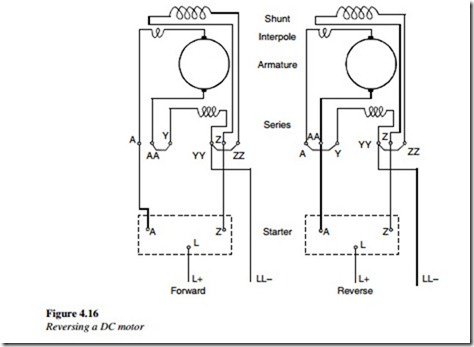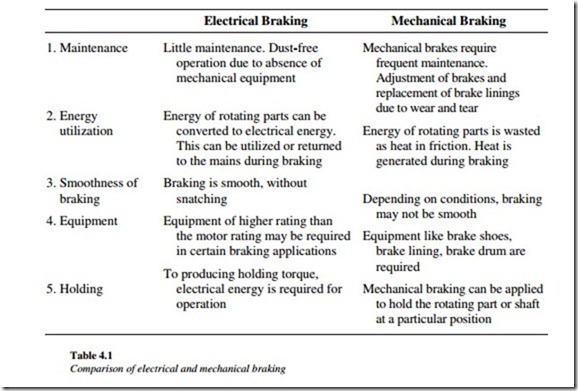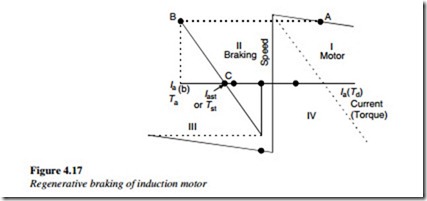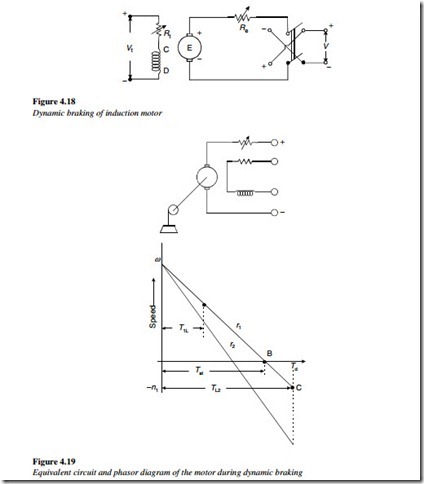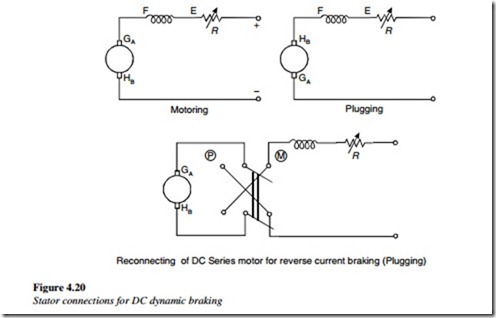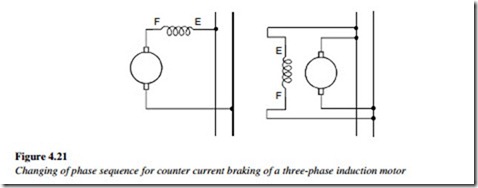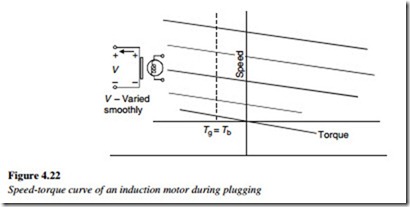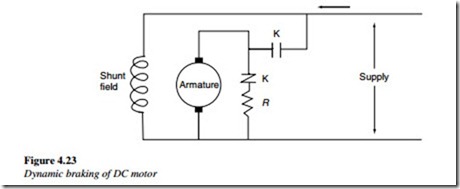Motor braking methods
Motor braking is to stop a running motor.
Removal of the supply given to the motor will make it stop. However, due to inertia, the motor will tend to rotate for some time before coming to a complete halt.
To stop the motor quickly, a braking mechanism is required. This is called motor braking.
While operating electrical drives, it is often necessary to stop the motor quickly and to reverse it. Particularly, in electrical hoist or crane applications, it is required to control the torque of the drive motor so that the load does not have undesired acceleration. Some applications require accurate positioning of the motor shaft.
The speed and accuracy of stopping and reversing operations of motors improve the productivity of the system. For example, take rolling mill motor application.
In such applications, braking torque is required which may be either electrical or mechanical. Braking can be broadly classified as:
• Electrical braking
• Mechanical braking.
(a) Electrical braking
In electrical braking, the winding of the motor is used to produce a braking torque. A braking torque is developed during the braking operation. This braking torque opposes the motion of the rotating member or shaft. This is achieved by suitably changing the electrical connections of the motor. The motor operates on a speed–torque characteristic, depending upon the method of braking employed.
(b) Mechanical braking
In mechanical braking, the frictional force between the rotating parts and the brake drums produces the required braking. To achieve this, mechanical equipment, such as brake linings and brake drums, are required. Whether electrical or mechanical, the braking of the drive should stop the motor at the specified point of time and position.
Little maintenance. Dust-free operation due to absence of mechanical equipment Energy of rotating parts can be converted to electrical energy. This can be utilized or returned to the mains during braking
Braking is smooth, without snatching
Equipment of higher rating than the motor rating may be required in certain braking applications To producing holding torque, electrical energy is required for operation
Mechanical brakes require frequent maintenance. Adjustment of brakes and replacement of brake linings due to wear and tear Energy of rotating parts is wasted as heat in friction. Heat is generated during braking Depending on conditions, braking may not be smooth Equipment like brake shoes, brake lining, brake drum are required From the above comparison of electrical and mechanical brakings, it is seen that electrical braking is more effective and superior to mechanical braking. However, for safety reasons, in hoist or crane applications a standby mechanical brake system is also provided to avoid accidents in case of power failure. However, in case of severe operating cycle of the motor, electrical braking should be employed only when it is highly desirable to control retardation and limit the braking time.
Electrical motors braking methods
Electrical braking may be achieved by the following:
• Counter current braking or plugging
• Regenerative braking
• Dynamic or rheostatic braking.
Electromechanical braking may be achieved through an electromechanical brake.
(a) Counter current braking or plugging
This is accomplished by momentarily connecting the motor in a forward direction, when the motor is already running in the reverse direction. It is accomplished in DC motors, by reversing the armature supply leads, so that the motor draws a current to develop a reverse torque, to oppose its already existing rotation.
The motor acts as a brake and comes quickly to rest but has the tendency to accelerate in a reverse direction. If the reversal is not required, the supply to the motor should be cut off at zero speed.
In case of a DC motor, this is achieved by reversing the polarity of the supply voltage to the armature; however, in case of AC motors the phase sequence is interchanged.
This method of braking is also used to maintain a constant speed when the load tries to accelerate the rotor to high speeds.
This method is inefficient because of the power loss in resistors, used for limiting the current due to an interconnection. The mechanical energy is converted to heat and additional power is required. At the same time, if for a large motor, sudden torque is applied, in the reverse direction by plugging, then it may result in damaging the machinery. This may result in a high current flow through the system.
(b) Electrical braking
In electrical braking, it is possible to convert the kinetic energy of the rotating parts to electrical energy and return it back to the mains or dissipate it in a resistance.
(c) Regenerative braking
The braking is called regenerative when the energy is returned to the mains supply. This method uses the motor as a generator during braking, developing a retarding torque, which acts on the running motor and halts it. The kinetic energy and potential energy, minus the losses of the motor are returned to the mains and the motor runs at a constant speed. Thus, regenerative braking eliminates the tendency of the load to accelerate the motor.
(d) Dynamic or rheostat braking
The braking is called dynamic or rheostatic braking when the energy is dissipated as heat in a resistance. In either case, the machine operates as a generator. Electric machines are capable of smooth transition from motor to generator action. In dynamic braking, the motor must be switched to the load or braking resistor keeping the field constant.
(e) Electromechanical friction braking
This is an external brake, used for stopping the motor as well as holding the motor at a single position. It consists of a solenoid along with a drum brake arrangement. When the motor is running, the solenoid is energized; so, it keeps the brake shoes away from the rotor shaft. As the motor is turned off, the solenoid is de-energized and the brake shoe acts on the rotating shaft. There is a braking action due to the friction between the brake shoe and the rotating shaft.
This kind of brake holds the load at one position, even after the motor stops. It is therefore used in applications that require the motor to be held at one position with the load, like in crane applications.
These brakes require more maintenance than purely electrical braking, because of the wear and tear on the brake shoe mechanism.
Induction motors braking methods
1. Regenerative braking
In an induction motor, when the rotor runs faster than the stator field’s synchronous speed, the slip becomes negative and the machine generates power.
Whenever the motor has a tendency to run faster than the rotating field, regenerative braking occurs and the kinetic energy of the rotating parts is returned to the mains.
The speed torque curve extends to the second quadrant as shown in Figure 4.17.
As the speed of the motor decreases, the braking torque makes the motor run at a constant speed and arrests its tendency to rotate faster. Due to the effects of stator resistance, the maximum torque developed during regeneration is greater than the maximum torque during motoring.
For example, in cranes and hoists, the motor has a tendency to run faster than the synchronous speed. This situation can occur when a hoist is raising an empty cage. Due to counter weight, the cage may acquire dangerous speeds. The transition takes place almost automatically, a torque is developed to arrest the acceleration, and regeneration takes place. Automatic regeneration arrests any undue acceleration. In such cases, the rotor resistance control could be employed to get a better braking torque.
Regenerative braking is also possible with a pole change motor, when the speed is changed from high to low. It can also be easily accomplished, in variable frequency drives by decreasing the frequency of the motor momentarily – the synchronous speed decreases and conditions favorable to regeneration are created.
As the motor speed decreases, the frequency is continuously reduced so that the braking takes place at a constant torque and stator current, until the motor comes to zero speed. During regenerative braking, there is a possibility of dangerous speeds, if the operating point during the braking falls in the unstable region of the characteristic. This happens if the load torque is greater than the breakdown torque of the motor. The torque developed cannot break the motor and undue acceleration takes place. This possibility can be eliminated by means of a high resistance in the rotor.
2. Dynamic braking
Dynamic braking is used to brake non-reversing drives. The stator is transferred from AC mains to DC mains, as shown in Figure 4.18.
The DC flowing through the stator sets up a stationary field. This induces rotor currents that produce a torque, to bring the rotor to rest quickly. The developed torque and retardation during braking may be controlled by the amount of the DC power. Additional resistances r1 and r2e in the stator and rotor circuits control the DC excitation and braking torques, respectively.
An equivalent circuit and phasor diagram of the motor during dynamic braking are shown in Figure 4.19.
When the stator is fed from the DC, the MMF produced is stationary. The MMF depends upon the stator connections for feeding the DC, the number of turns, and the current. The possible connections of the stator for feeding the DC are shown in Figure 4.20.
Dynamic braking is employed in conjunction with automatic control. Induction motors are more popular in hoists than in DC motors due to this reason. Methods of feeding the DC supply to the stator are shown in Figure 4.20. The limiting resistor R controls DC excitation.
Torque control is achieved by a rotor resistance variation. Alternately, an AC supply with a bridge rectifier may be used to feed the motor.
In AC dynamic braking, the stator is switched to a capacitance bank. The machine runs as a self-excited induction generator. All the mechanical energy is dissipated as electrical energy in the rotor resistance. This method is un-economical due to a high cost of capacitors.
3. Counter current braking or plugging
In an induction motor, by changing the phase sequence of the input supply, the direction of the stator field can be reversed. This is also called plugging.
In practice, interchanging the supply to any two terminals of the motors, as shown in Figure 4.21, does this.
When the phase sequence of the input supply is changed, this reverses the direction of the revolving flux, which produces a torque in the reverse direction, thus applying a brake on the motor. During this braking action, the motor absorbs kinetic energy from the revolving load, causing speed reduction and bringing the motor to a rest. The motor must be switched off, as it approaches zero speed.
In high-capacity motors, if sudden torque is applied in a reverse direction (plugging), without slowing down the motor, then it can result in a mechanical damage. To avoid this, anti-plugging protection is used, which does not allow a reverse torque to be applied, unless the speed of the motor reduces below the acceptable value.
The speed–torque characteristics of an induction motor can be modified by varying the rotor resistance.
The maximum torque point can be achieved in the range of slips1–2,where the torque developed tends to brake the rotor. The torque developed can also be used to arrest the tendency of the rotor to accelerate. A high resistance is introduced in the rotor, so that the operating point shifts to the fourth quadrant.
The braking torque developed prevents any acceleration of the rotor which now works at a uniform speed, as shown in Figure 4.22.
The total braking torque (TP) may be controlled with a variable rotor resistance, which limits the braking current.
Synchronous motors braking methods
(a) Regenerative braking
When a synchronous motor operates as a variable speed drive (VSD), utilizing a variable frequency supply, regenerative braking can be applied, and all the kinetic energy will return to the mains.
As in the case of an induction motor, regeneration is possible if the synchronous speed is less than the rotor speed.
Similarly, for a synchronous motor, the input frequency is gradually decreased to achieve this. The kinetic energy of the rotating parts is returned to the mains. The braking takes place at a constant torque.
(b) Dynamic braking
To achieve dynamic braking, a synchronous motor is switched on to a three-phase balanced-resistive load, after disconnecting it from the mains, keeping the excitation constant.
To achieve a greater braking torque for effective braking, the excitation may be increased.
The terminal voltage and current decrease as the speed decreases. At very low speeds, the resistance effect is considerable. The resistance affects the speed at the maximum torque. The maximum torque can be ideally made to occur just before the motor is stopped.
(c) Plugging
The braking of a synchronous motor, by the plugging method, has major disadvantages, such as very heavy braking current flow. This causes line disturbances and an ineffective torque.
Plugging can be used for braking, if the motor is a synchronous induction motor and only if the machine is working as an induction motor.
DC motors
A motor and its load can be brought to rest quickly by using either of the following:
• Friction braking
• Electric braking.
The common mechanical brake has one drawback. Smooth braking is difficult to achieve, apart from the fact that, it largely depends on the operator’s skill.
Electric braking methods eliminate the need for brake linings, levers, etc. There are three methods of electric braking both for shunt and series motors:
• Rheostatic or dynamic braking
• Plugging or reversal of torque
• Regenerative braking.
A friction brake, however, is necessary for holding the motor, even after it has been brought to rest. This is so even in the case of electric braking.
Shunt motor
(a) Rheostatic or dynamic braking
In this method, the armature of the motor is disconnected from the supply and is connected across a variable resistance. The field winding is not disturbed.
As shown in Figure 4.23, a braking resistor is placed across the armature winding with
![]() an NC contact of motor start contact (K) in series. So, when the motor runs, the braking resistor remains isolated.
an NC contact of motor start contact (K) in series. So, when the motor runs, the braking resistor remains isolated.
When the stop button is pressed, the braking resistor will function as a load. It will dissipate the stored energy till the motor stops.
Varying the series resistance controls the braking. The smaller the value of the resistance, the higher the rate at which the energy stored will be dissipated and the earlier the motor will stop.
(b) Plugging or reverse current braking
In this method, the connections to the armature terminals are reversed so that the motor tends to run in the opposite direction.
Plugging gives a greater braking torque than rheostatic braking. Obviously, during plugging, the power is drawn from the supply and is dissipated in the form of heat. If the motor is of a large capacity, then due to plugging, there may be a rise in the current. The resultant application of sudden reverse torque may damage the machinery.
(c) Regenerative braking
This method is used when the load on the motor has an overhauling characteristic, as happens when lowering the load in a crane or in the downhill motion of an electric train. Regeneration takes place in such a situation, as the motor acts as a generator, returning power to the line, which may be used for supplying another train, thereby relieving the powerhouse of part of the load.
Series motor
(a) Rheostatic braking
In this type of braking, the motor is disconnected from the supply. The field connections are reversed and the motor is connected in series with a variable resistance. The machine now acts as a generator. The variable resistance employed for starting is, in itself, useful for braking, in a number of applications.
(b) Plugging or reverse current braking
As in the case of shunt motors, in the series motor too, the connections of the armature are reversed and a variable resistance is introduced in series with the armature.
(c) Regenerative braking
This type of braking of a series motor is not possible, without modification in the series motor. However, this method is sometimes used with traction motors, with special arrangements for the purpose.
